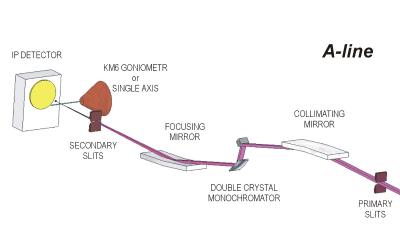BM01
S t a t i o n B e n d i n g M a g n e t 01 (B M 01)
General description B M 01
DIFFRACTION STUDIES
Scientific applications:
BM01 caters for high resolution single-crystal diffraction, small molecules, and for macromolecular crystallography.
Optics for BM01:
| Optical elements | Mirror 1 | Double-crystal mono. | Mirror 2 |
| Distance from source | 25.9m | 28.5m | 30.8 m |
| Focusing type | Rh coated
Vert. collim. |
Si (111)
Sagittally focusing |
Rh coated
Vert. focusing |
| Beam size at sample | Nominally 0.5 x 0.5 mm2 FWHM focused | ||
| Spectral range | 10 - 22 keV | ||
| Horizontal acceptance | 2 mrad | ||
Design and General Layout
The beamline is installed on a bending magnet source (dipole BM 1). The incoming beam is first divided into two separate beams. In the case of the BM1A station a 2 mrad fan of radiation will first be vertically collimated by a primary mirror. The mirror angle relative to the incident beam is nominally set to 3 mrad. With the Rh coating on the silicon mirror, this angle of incidence leads to an energy cut-off at about 24 keV. Reflection from this mirror will produce a highly parallel beam incident onto a double crystal monochromator, enabling to achieve both high throughput and narrow energy resolution. The station is designed such that operation with or without the mirrors is possible. The first crystal of the monochromator is water cooled, while the second crystal can be sagittally bent for horizontal focusing. A variable gap between the two crystals, combined with a translation of the second crystal along the beam direction, allows for a fixed exit beam height. Alternatively, a flat second crystal can be mounted in place of the sagittally bent crystal, for experiments requiring parallel beam optics. Fixed Be windows are mounted immediately before and after the monochromator vessel allowing to perform changes in the monochromator vessel without disturbing the vacuum in the adjacent vessels. A fixed beam-stop positioned after this vessel intercepts the remains of the white beam and the Bremsstrahlung radiation. This beam-stop can not be removed, and is integrated into the Personnel Safety System (PSS). An adjustable beam-stop is also available to intercept the white beam reflected from the first mirror. Finally a secondary mirror provides vertical focusing at the sample position in the second hutch (BM1A). Between each of the optical elements (mirror - monochromator - mirror) a slit vessel is installed which contains a set of motorised, horizontal and vertical slits. These function both as anti-scatter slits and beam collimators. A final set of motorised horizontal and vertical slits is installed at the end of the vacuum line inside the experimental hutch. A kapton scatter foil and a scintillation counter mounted immediately in front of the exit window are used to monitor the beam intensity.

Fig. BM01
Schematic layout of the Swiss-Norwegian beamline BM01
The following equipment is installed on station BM01:
Multipurpose PILATUS@SNBL diffractometer
The diffractometer is based on PILATUS2M detector, it combines advantages of pixel area detector with flexible goniometry and easy re-positioning of the detector in vertical and horizontal directions. The diffractometer can be used for single crystal, powder, and thin film diffraction experiments.



